Personal Development Planning: Portfolio for Study Skills Module, UWS
VerifiedAdded on 2022/11/24
|26
|4691
|227
Homework Assignment
AI Summary
This document is a personal development portfolio created as part of a Study Skills module at the University of the West Scotland (UWS). The portfolio guides students through a structured process of self-assessment, goal setting, and action planning to enhance their personal and professional development. It includes questionnaires to identify strengths and weaknesses, future aspirations, and priorities. Students complete self and peer evaluations, analyze personality traits, and create SWOT analyses. The portfolio also incorporates a personal action plan with SMART goals, time management logs, and learning style assessments. Throughout the course, students reflect on their progress using a PDP diary, culminating in a final evaluation of their journey. The assignment aims to equip students with the skills needed for success in their studies and future careers.
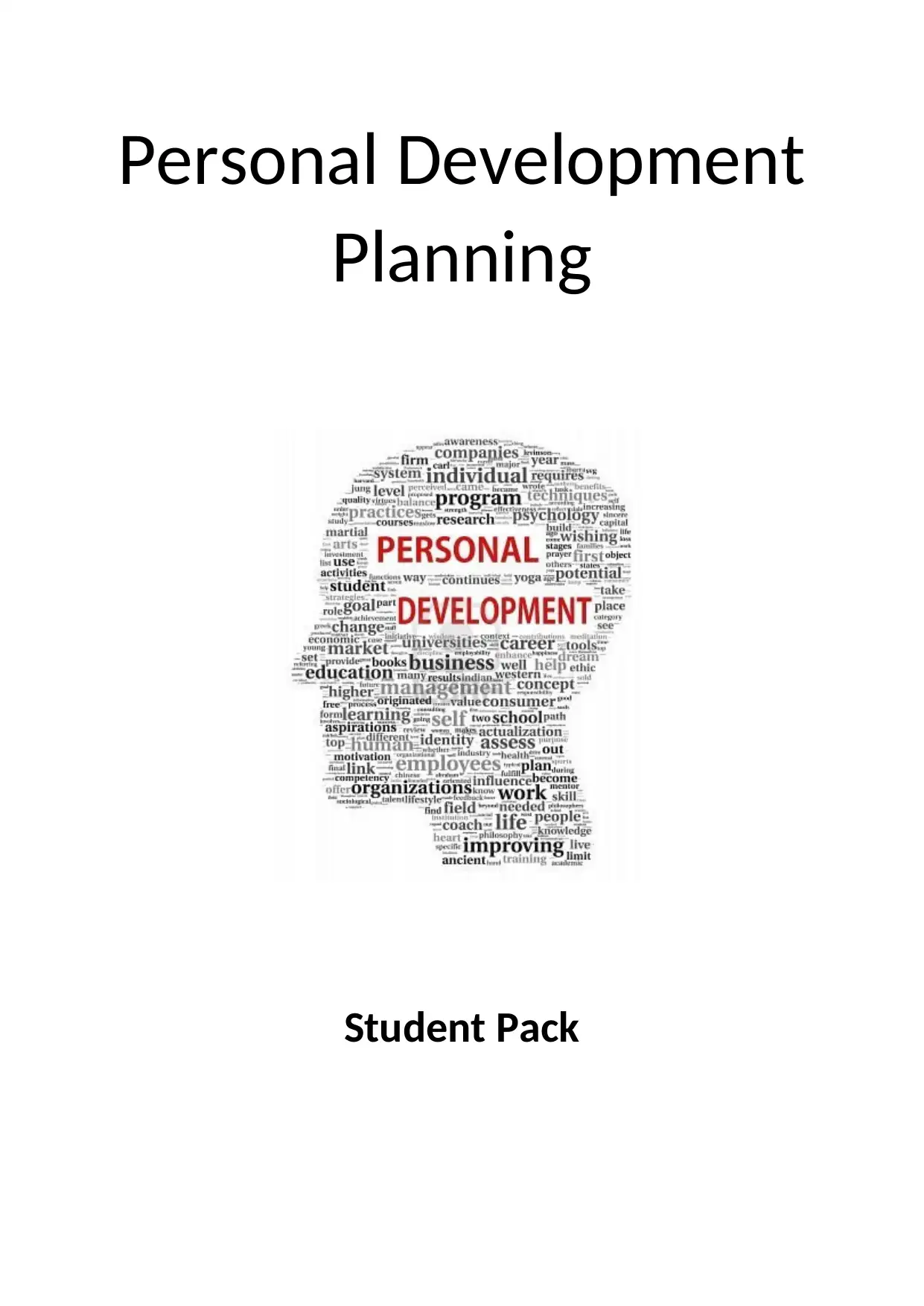
Personal Development
Planning
Student Pack
Planning
Student Pack
Paraphrase This Document
Need a fresh take? Get an instant paraphrase of this document with our AI Paraphraser
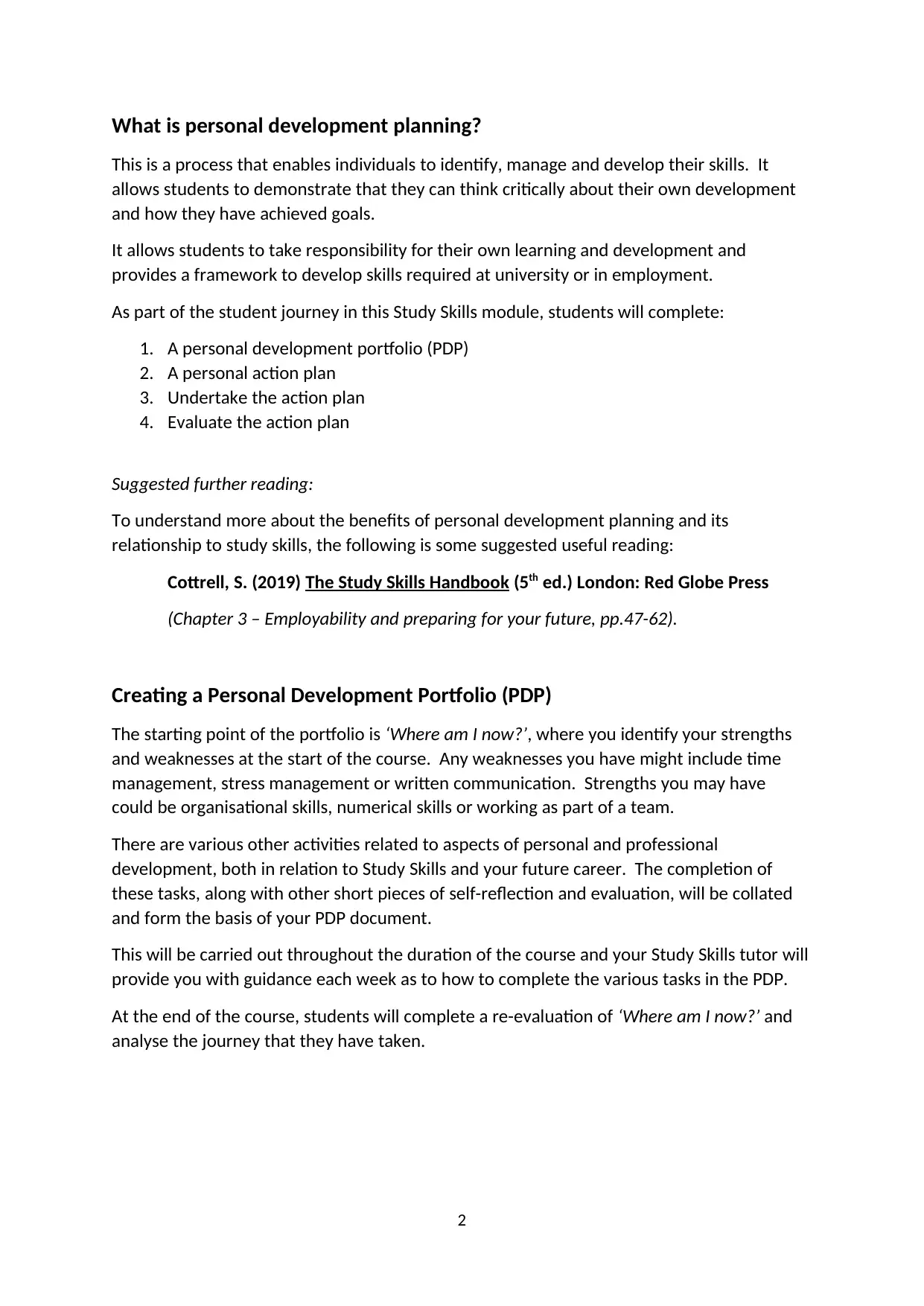
What is personal development planning?
This is a process that enables individuals to identify, manage and develop their skills. It
allows students to demonstrate that they can think critically about their own development
and how they have achieved goals.
It allows students to take responsibility for their own learning and development and
provides a framework to develop skills required at university or in employment.
As part of the student journey in this Study Skills module, students will complete:
1. A personal development portfolio (PDP)
2. A personal action plan
3. Undertake the action plan
4. Evaluate the action plan
Suggested further reading:
To understand more about the benefits of personal development planning and its
relationship to study skills, the following is some suggested useful reading:
Cottrell, S. (2019) The Study Skills Handbook (5th ed.) London: Red Globe Press
(Chapter 3 – Employability and preparing for your future, pp.47-62).
Creating a Personal Development Portfolio (PDP)
The starting point of the portfolio is ‘Where am I now?’, where you identify your strengths
and weaknesses at the start of the course. Any weaknesses you have might include time
management, stress management or written communication. Strengths you may have
could be organisational skills, numerical skills or working as part of a team.
There are various other activities related to aspects of personal and professional
development, both in relation to Study Skills and your future career. The completion of
these tasks, along with other short pieces of self-reflection and evaluation, will be collated
and form the basis of your PDP document.
This will be carried out throughout the duration of the course and your Study Skills tutor will
provide you with guidance each week as to how to complete the various tasks in the PDP.
At the end of the course, students will complete a re-evaluation of ‘Where am I now?’ and
analyse the journey that they have taken.
2
This is a process that enables individuals to identify, manage and develop their skills. It
allows students to demonstrate that they can think critically about their own development
and how they have achieved goals.
It allows students to take responsibility for their own learning and development and
provides a framework to develop skills required at university or in employment.
As part of the student journey in this Study Skills module, students will complete:
1. A personal development portfolio (PDP)
2. A personal action plan
3. Undertake the action plan
4. Evaluate the action plan
Suggested further reading:
To understand more about the benefits of personal development planning and its
relationship to study skills, the following is some suggested useful reading:
Cottrell, S. (2019) The Study Skills Handbook (5th ed.) London: Red Globe Press
(Chapter 3 – Employability and preparing for your future, pp.47-62).
Creating a Personal Development Portfolio (PDP)
The starting point of the portfolio is ‘Where am I now?’, where you identify your strengths
and weaknesses at the start of the course. Any weaknesses you have might include time
management, stress management or written communication. Strengths you may have
could be organisational skills, numerical skills or working as part of a team.
There are various other activities related to aspects of personal and professional
development, both in relation to Study Skills and your future career. The completion of
these tasks, along with other short pieces of self-reflection and evaluation, will be collated
and form the basis of your PDP document.
This will be carried out throughout the duration of the course and your Study Skills tutor will
provide you with guidance each week as to how to complete the various tasks in the PDP.
At the end of the course, students will complete a re-evaluation of ‘Where am I now?’ and
analyse the journey that they have taken.
2
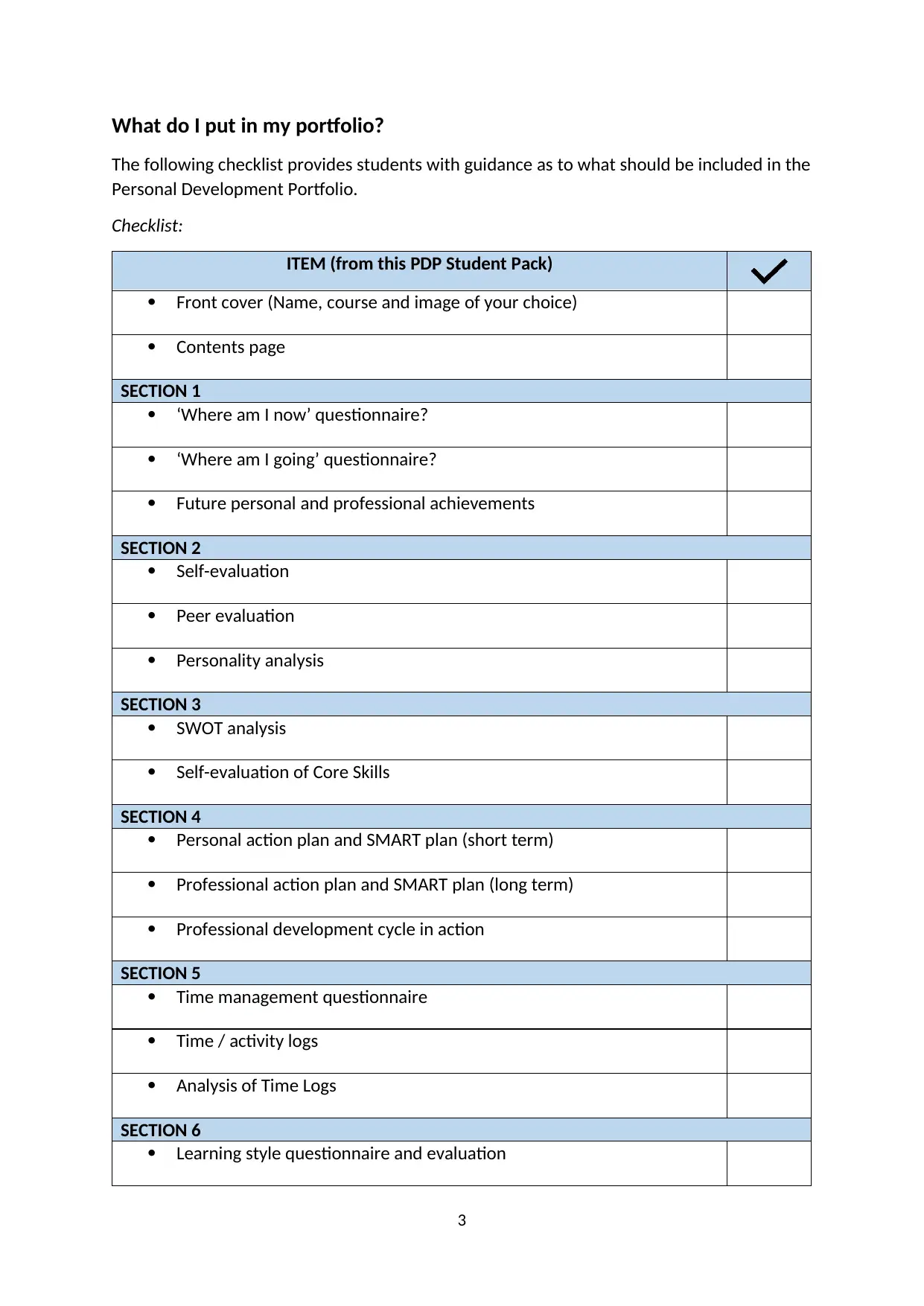
What do I put in my portfolio?
The following checklist provides students with guidance as to what should be included in the
Personal Development Portfolio.
Checklist:
ITEM (from this PDP Student Pack)
Front cover (Name, course and image of your choice)
Contents page
SECTION 1
‘Where am I now’ questionnaire?
‘Where am I going’ questionnaire?
Future personal and professional achievements
SECTION 2
Self-evaluation
Peer evaluation
Personality analysis
SECTION 3
SWOT analysis
Self-evaluation of Core Skills
SECTION 4
Personal action plan and SMART plan (short term)
Professional action plan and SMART plan (long term)
Professional development cycle in action
SECTION 5
Time management questionnaire
Time / activity logs
Analysis of Time Logs
SECTION 6
Learning style questionnaire and evaluation
3
The following checklist provides students with guidance as to what should be included in the
Personal Development Portfolio.
Checklist:
ITEM (from this PDP Student Pack)
Front cover (Name, course and image of your choice)
Contents page
SECTION 1
‘Where am I now’ questionnaire?
‘Where am I going’ questionnaire?
Future personal and professional achievements
SECTION 2
Self-evaluation
Peer evaluation
Personality analysis
SECTION 3
SWOT analysis
Self-evaluation of Core Skills
SECTION 4
Personal action plan and SMART plan (short term)
Professional action plan and SMART plan (long term)
Professional development cycle in action
SECTION 5
Time management questionnaire
Time / activity logs
Analysis of Time Logs
SECTION 6
Learning style questionnaire and evaluation
3
⊘ This is a preview!⊘
Do you want full access?
Subscribe today to unlock all pages.

Trusted by 1+ million students worldwide
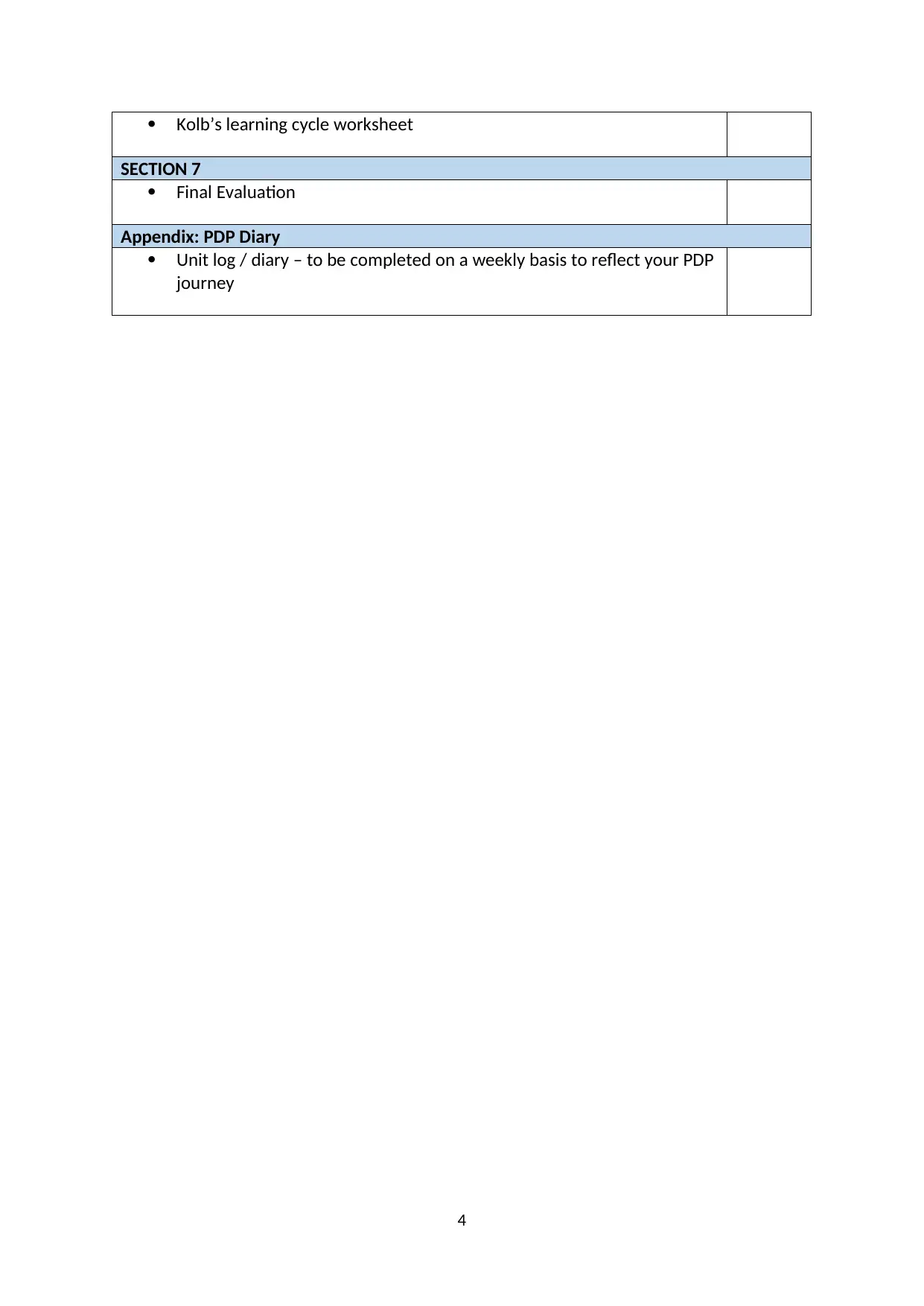
Kolb’s learning cycle worksheet
SECTION 7
Final Evaluation
Appendix: PDP Diary
Unit log / diary – to be completed on a weekly basis to reflect your PDP
journey
4
SECTION 7
Final Evaluation
Appendix: PDP Diary
Unit log / diary – to be completed on a weekly basis to reflect your PDP
journey
4
Paraphrase This Document
Need a fresh take? Get an instant paraphrase of this document with our AI Paraphraser
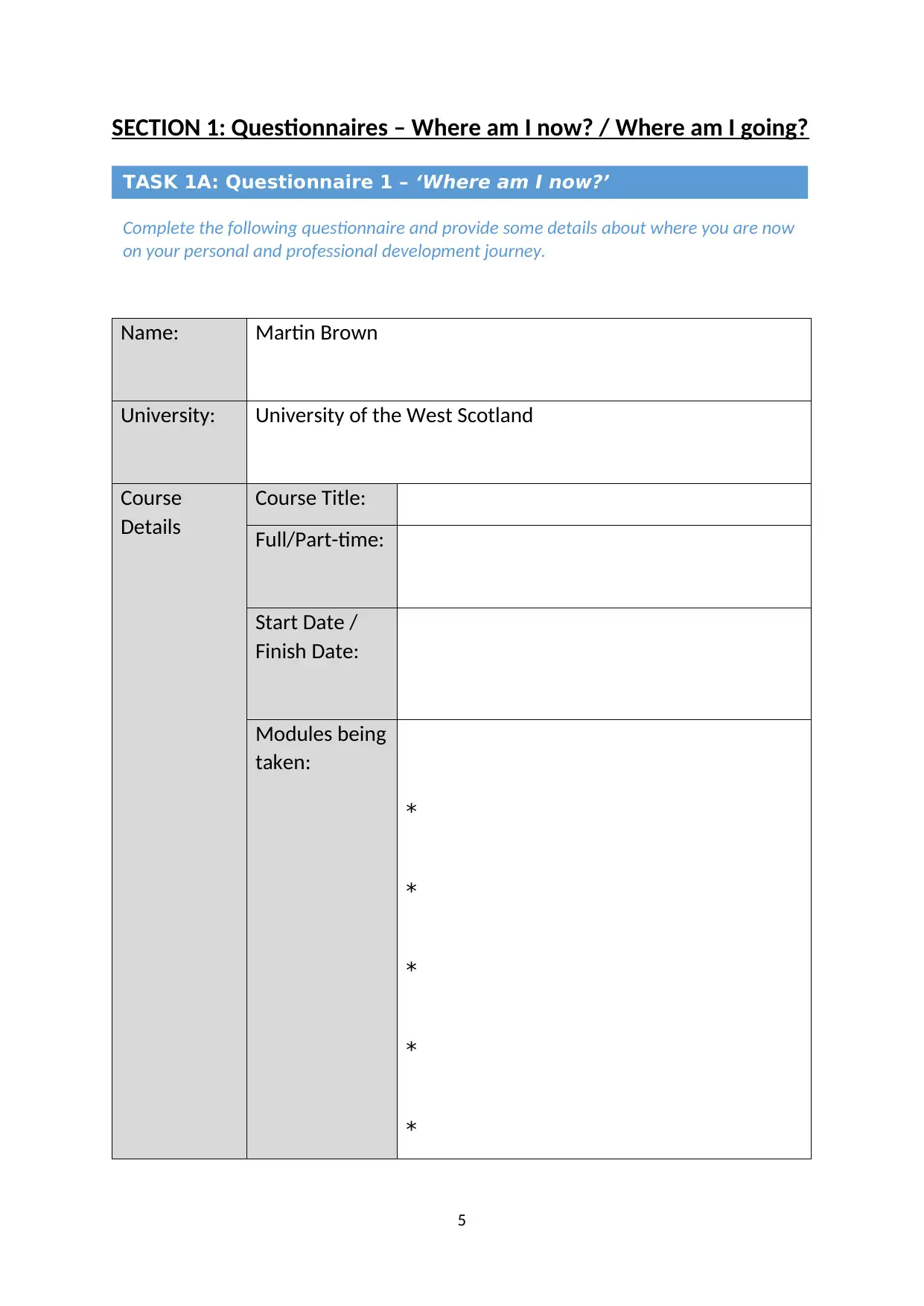
SECTION 1: Questionnaires – Where am I now? / Where am I going?
Name: Martin Brown
University: University of the West Scotland
Course
Details
Course Title:
Full/Part-time:
Start Date /
Finish Date:
Modules being
taken:
*
*
*
*
*
5
TASK 1A: Questionnaire 1 – ‘Where am I now?’
Complete the following questionnaire and provide some details about where you are now
on your personal and professional development journey.
Name: Martin Brown
University: University of the West Scotland
Course
Details
Course Title:
Full/Part-time:
Start Date /
Finish Date:
Modules being
taken:
*
*
*
*
*
5
TASK 1A: Questionnaire 1 – ‘Where am I now?’
Complete the following questionnaire and provide some details about where you are now
on your personal and professional development journey.
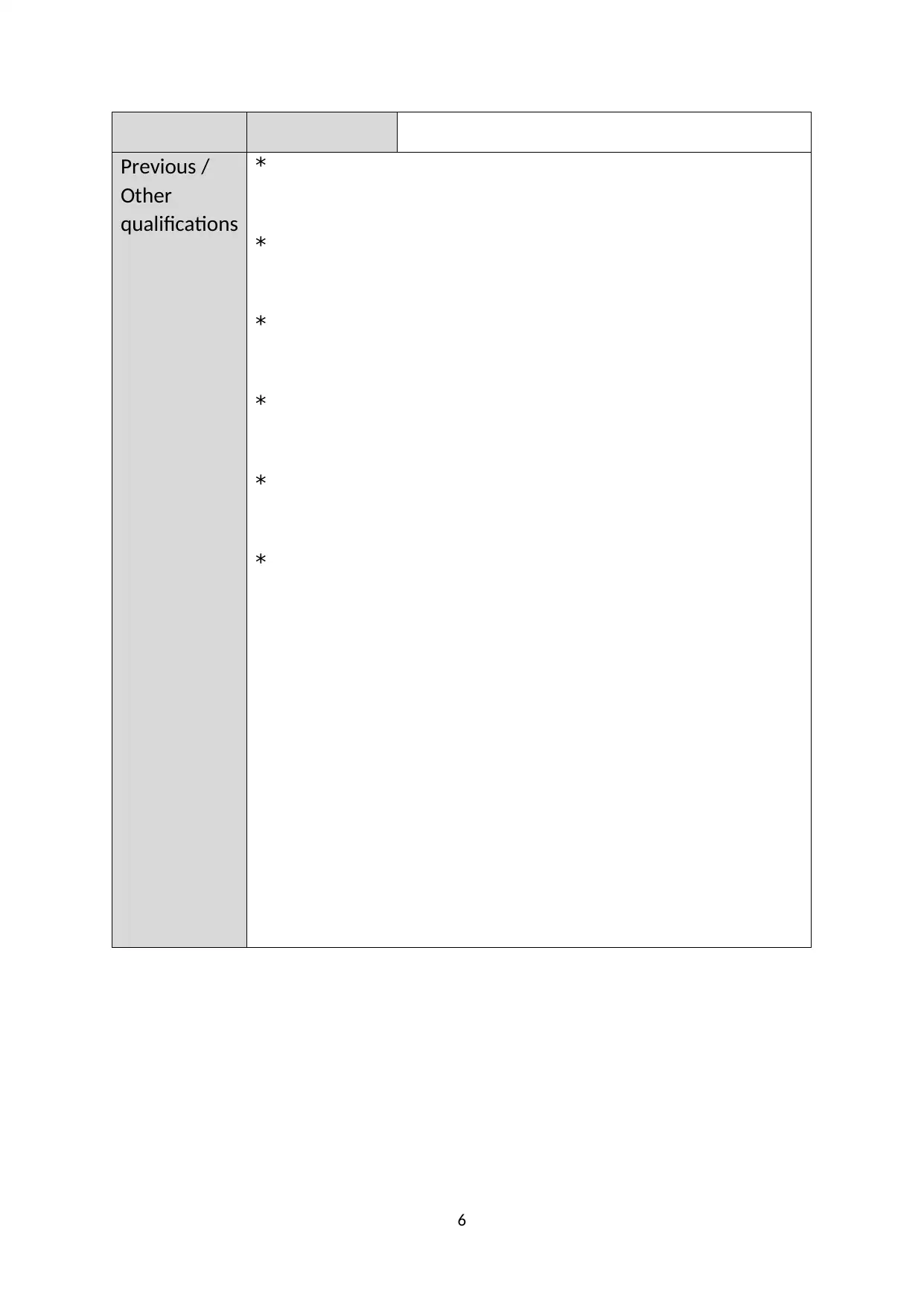
Previous /
Other
qualifications
*
*
*
*
*
*
6
Other
qualifications
*
*
*
*
*
*
6
⊘ This is a preview!⊘
Do you want full access?
Subscribe today to unlock all pages.

Trusted by 1+ million students worldwide
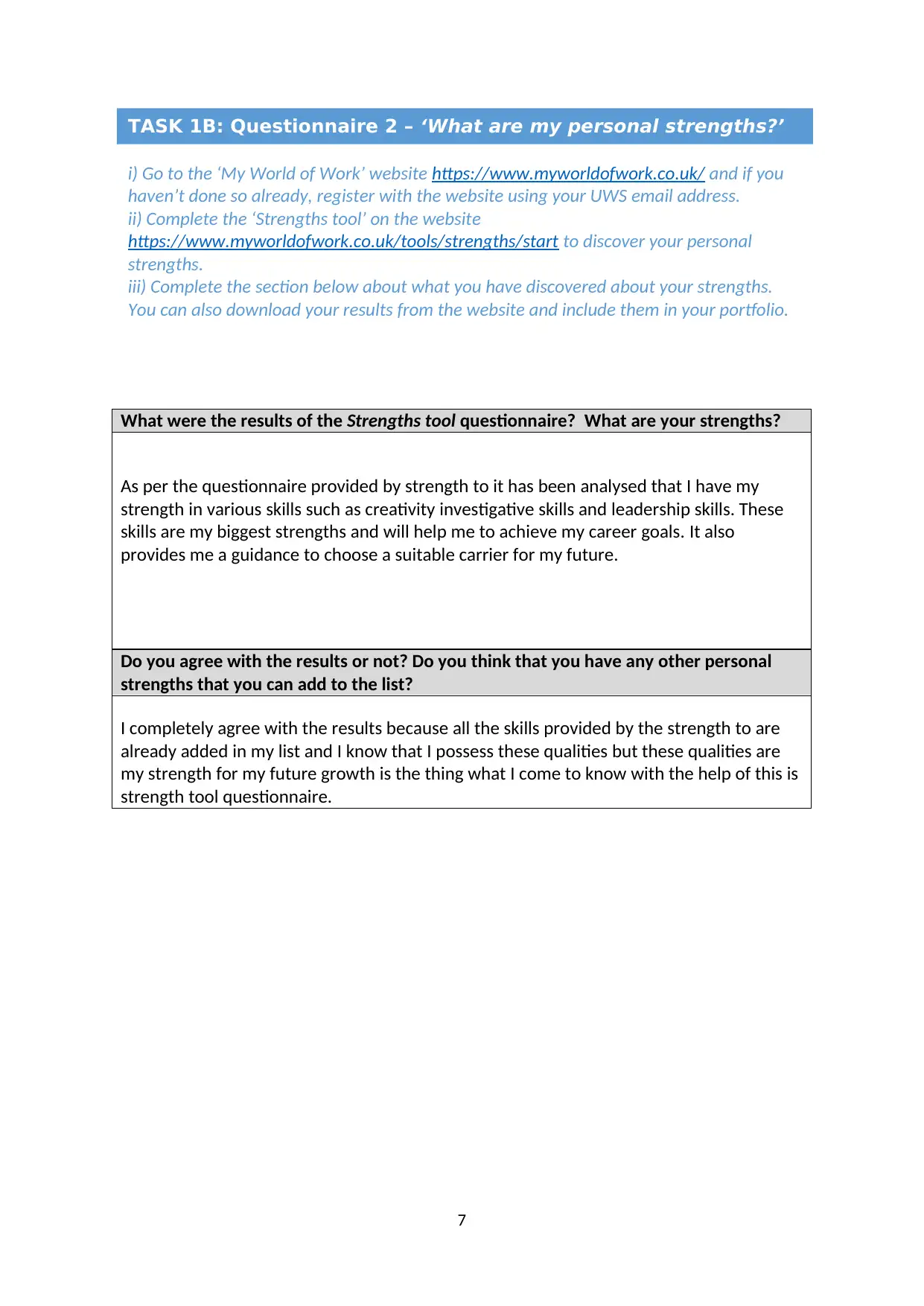
What were the results of the Strengths tool questionnaire? What are your strengths?
As per the questionnaire provided by strength to it has been analysed that I have my
strength in various skills such as creativity investigative skills and leadership skills. These
skills are my biggest strengths and will help me to achieve my career goals. It also
provides me a guidance to choose a suitable carrier for my future.
Do you agree with the results or not? Do you think that you have any other personal
strengths that you can add to the list?
I completely agree with the results because all the skills provided by the strength to are
already added in my list and I know that I possess these qualities but these qualities are
my strength for my future growth is the thing what I come to know with the help of this is
strength tool questionnaire.
7
TASK 1B: Questionnaire 2 – ‘What are my personal strengths?’
i) Go to the ‘My World of Work’ website https://www.myworldofwork.co.uk/ and if you
haven’t done so already, register with the website using your UWS email address.
ii) Complete the ‘Strengths tool’ on the website
https://www.myworldofwork.co.uk/tools/strengths/start to discover your personal
strengths.
iii) Complete the section below about what you have discovered about your strengths.
You can also download your results from the website and include them in your portfolio.
As per the questionnaire provided by strength to it has been analysed that I have my
strength in various skills such as creativity investigative skills and leadership skills. These
skills are my biggest strengths and will help me to achieve my career goals. It also
provides me a guidance to choose a suitable carrier for my future.
Do you agree with the results or not? Do you think that you have any other personal
strengths that you can add to the list?
I completely agree with the results because all the skills provided by the strength to are
already added in my list and I know that I possess these qualities but these qualities are
my strength for my future growth is the thing what I come to know with the help of this is
strength tool questionnaire.
7
TASK 1B: Questionnaire 2 – ‘What are my personal strengths?’
i) Go to the ‘My World of Work’ website https://www.myworldofwork.co.uk/ and if you
haven’t done so already, register with the website using your UWS email address.
ii) Complete the ‘Strengths tool’ on the website
https://www.myworldofwork.co.uk/tools/strengths/start to discover your personal
strengths.
iii) Complete the section below about what you have discovered about your strengths.
You can also download your results from the website and include them in your portfolio.
Paraphrase This Document
Need a fresh take? Get an instant paraphrase of this document with our AI Paraphraser
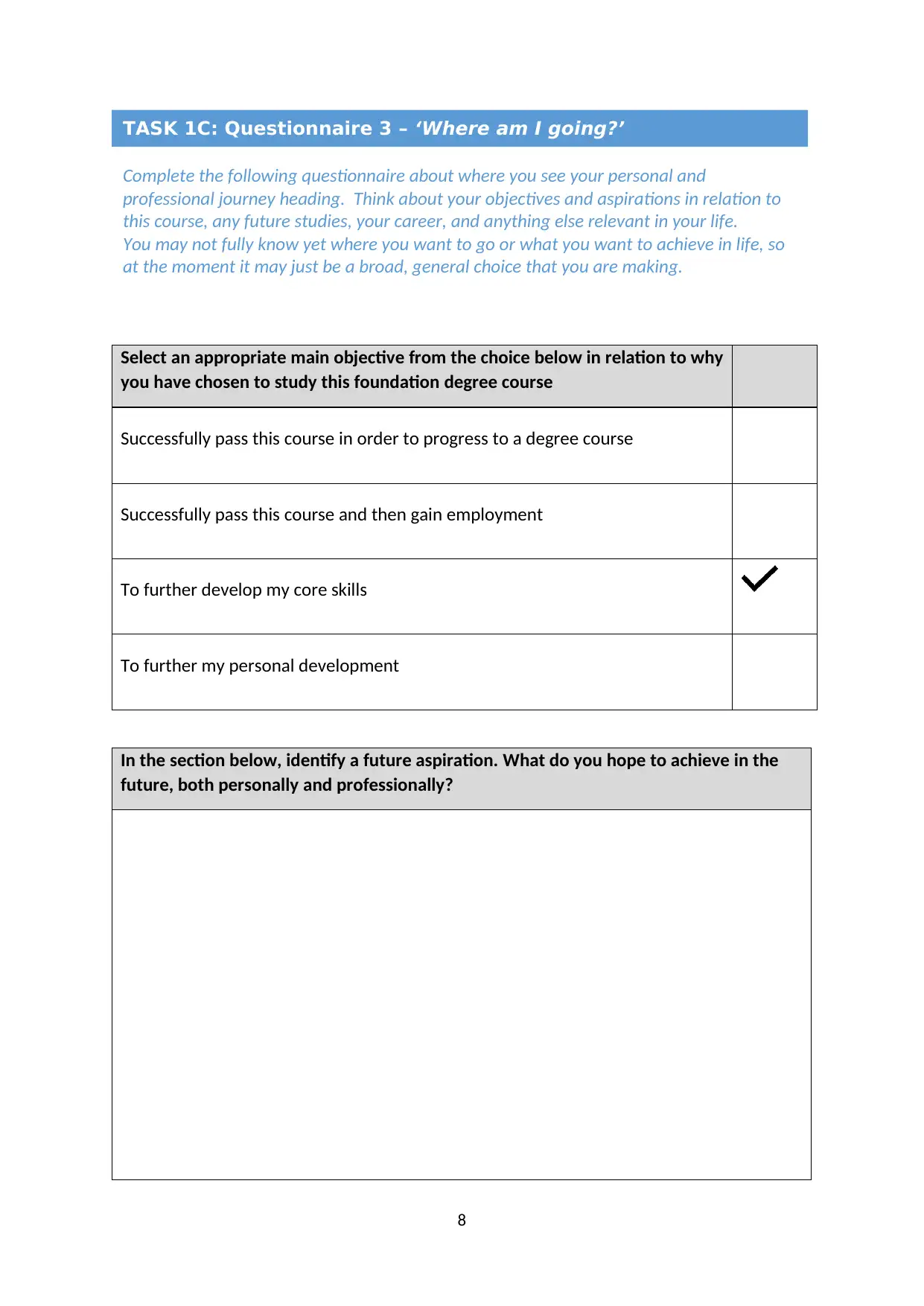
Select an appropriate main objective from the choice below in relation to why
you have chosen to study this foundation degree course
Successfully pass this course in order to progress to a degree course
Successfully pass this course and then gain employment
To further develop my core skills
To further my personal development
In the section below, identify a future aspiration. What do you hope to achieve in the
future, both personally and professionally?
8
TASK 1C: Questionnaire 3 – ‘Where am I going?’
Complete the following questionnaire about where you see your personal and
professional journey heading. Think about your objectives and aspirations in relation to
this course, any future studies, your career, and anything else relevant in your life.
You may not fully know yet where you want to go or what you want to achieve in life, so
at the moment it may just be a broad, general choice that you are making.
you have chosen to study this foundation degree course
Successfully pass this course in order to progress to a degree course
Successfully pass this course and then gain employment
To further develop my core skills
To further my personal development
In the section below, identify a future aspiration. What do you hope to achieve in the
future, both personally and professionally?
8
TASK 1C: Questionnaire 3 – ‘Where am I going?’
Complete the following questionnaire about where you see your personal and
professional journey heading. Think about your objectives and aspirations in relation to
this course, any future studies, your career, and anything else relevant in your life.
You may not fully know yet where you want to go or what you want to achieve in life, so
at the moment it may just be a broad, general choice that you are making.
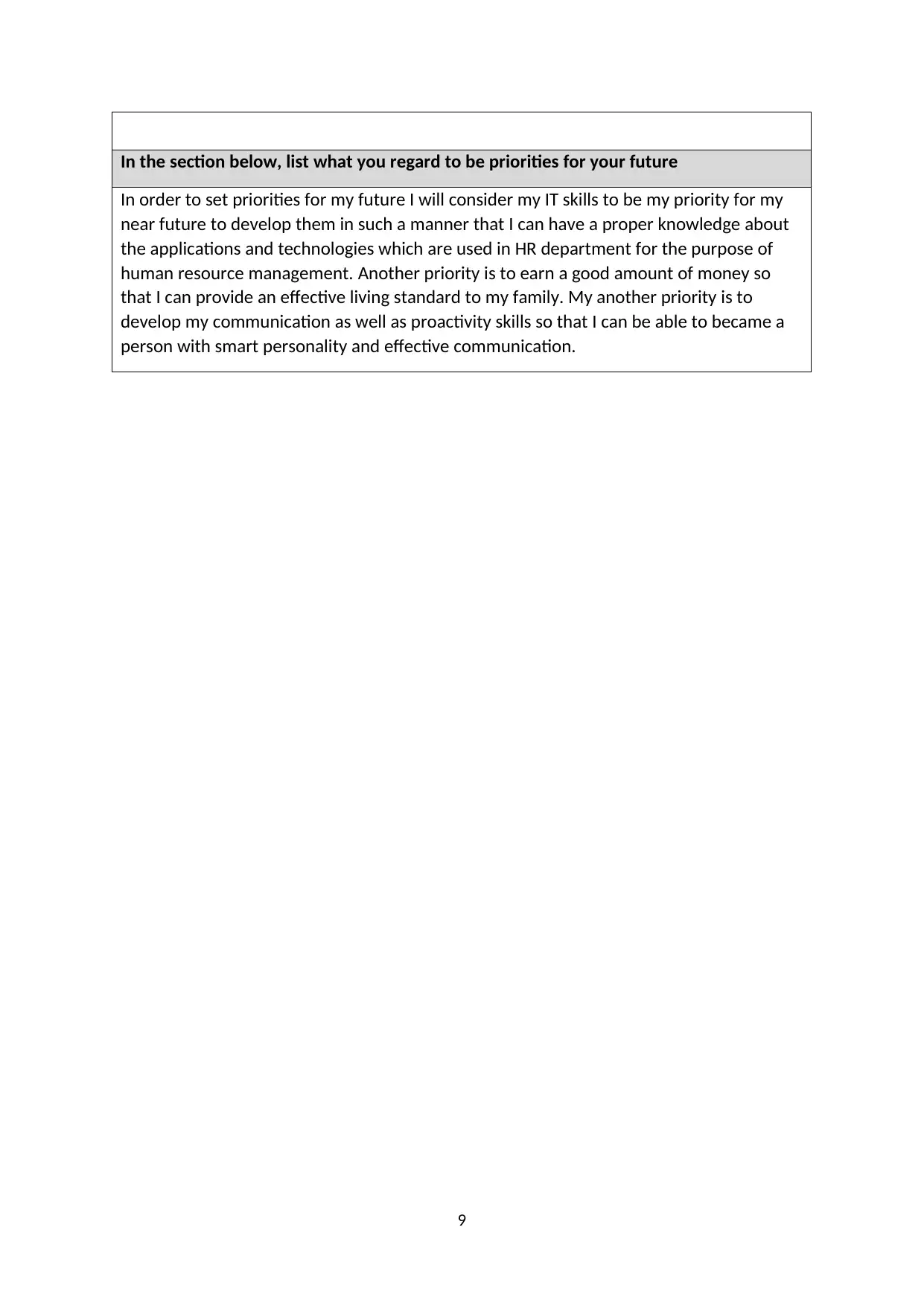
In the section below, list what you regard to be priorities for your future
In order to set priorities for my future I will consider my IT skills to be my priority for my
near future to develop them in such a manner that I can have a proper knowledge about
the applications and technologies which are used in HR department for the purpose of
human resource management. Another priority is to earn a good amount of money so
that I can provide an effective living standard to my family. My another priority is to
develop my communication as well as proactivity skills so that I can be able to became a
person with smart personality and effective communication.
9
In order to set priorities for my future I will consider my IT skills to be my priority for my
near future to develop them in such a manner that I can have a proper knowledge about
the applications and technologies which are used in HR department for the purpose of
human resource management. Another priority is to earn a good amount of money so
that I can provide an effective living standard to my family. My another priority is to
develop my communication as well as proactivity skills so that I can be able to became a
person with smart personality and effective communication.
9
⊘ This is a preview!⊘
Do you want full access?
Subscribe today to unlock all pages.

Trusted by 1+ million students worldwide
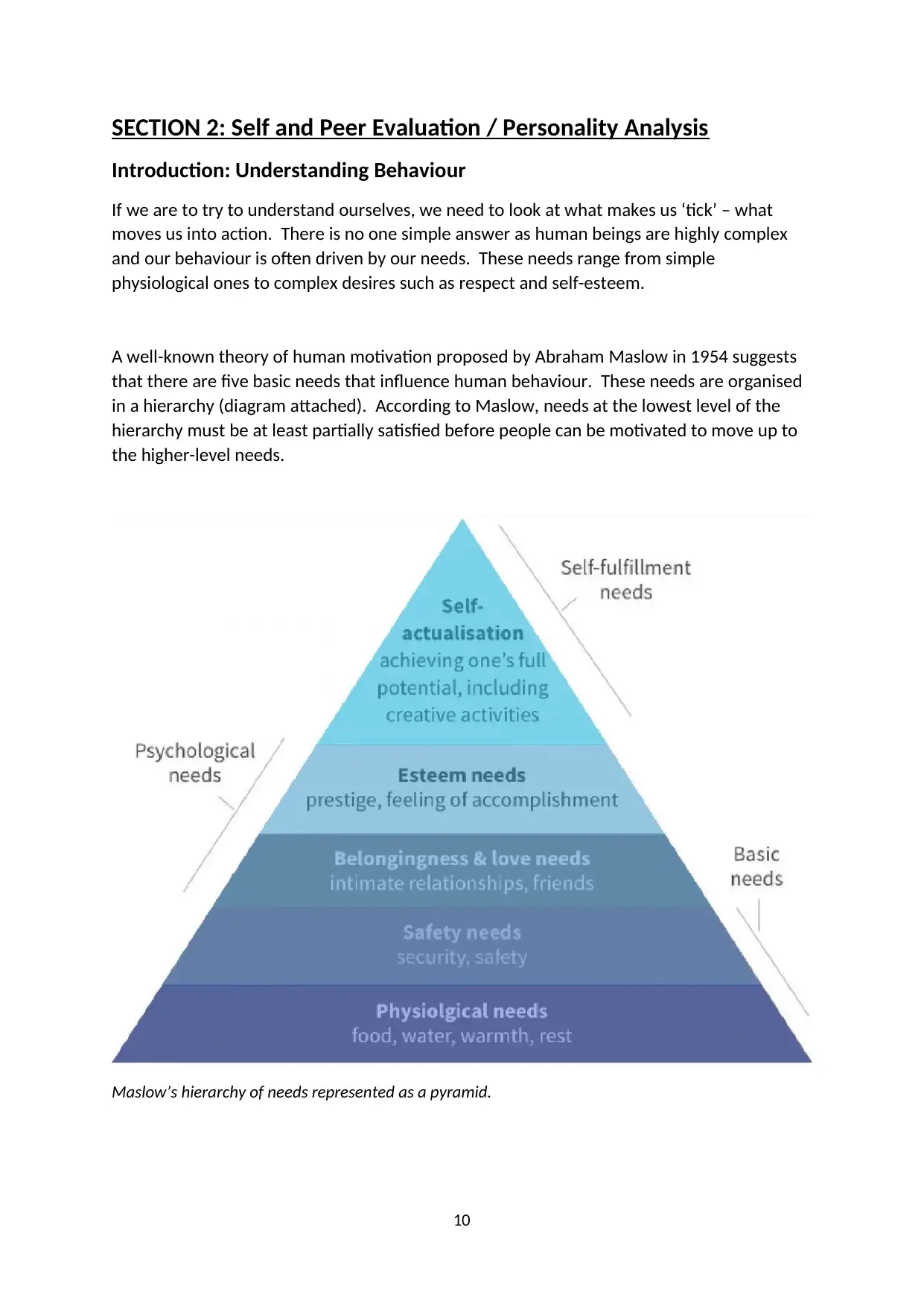
SECTION 2: Self and Peer Evaluation / Personality Analysis
Introduction: Understanding Behaviour
If we are to try to understand ourselves, we need to look at what makes us ‘tick’ – what
moves us into action. There is no one simple answer as human beings are highly complex
and our behaviour is often driven by our needs. These needs range from simple
physiological ones to complex desires such as respect and self-esteem.
A well-known theory of human motivation proposed by Abraham Maslow in 1954 suggests
that there are five basic needs that influence human behaviour. These needs are organised
in a hierarchy (diagram attached). According to Maslow, needs at the lowest level of the
hierarchy must be at least partially satisfied before people can be motivated to move up to
the higher-level needs.
Maslow’s hierarchy of needs represented as a pyramid.
10
Introduction: Understanding Behaviour
If we are to try to understand ourselves, we need to look at what makes us ‘tick’ – what
moves us into action. There is no one simple answer as human beings are highly complex
and our behaviour is often driven by our needs. These needs range from simple
physiological ones to complex desires such as respect and self-esteem.
A well-known theory of human motivation proposed by Abraham Maslow in 1954 suggests
that there are five basic needs that influence human behaviour. These needs are organised
in a hierarchy (diagram attached). According to Maslow, needs at the lowest level of the
hierarchy must be at least partially satisfied before people can be motivated to move up to
the higher-level needs.
Maslow’s hierarchy of needs represented as a pyramid.
10
Paraphrase This Document
Need a fresh take? Get an instant paraphrase of this document with our AI Paraphraser
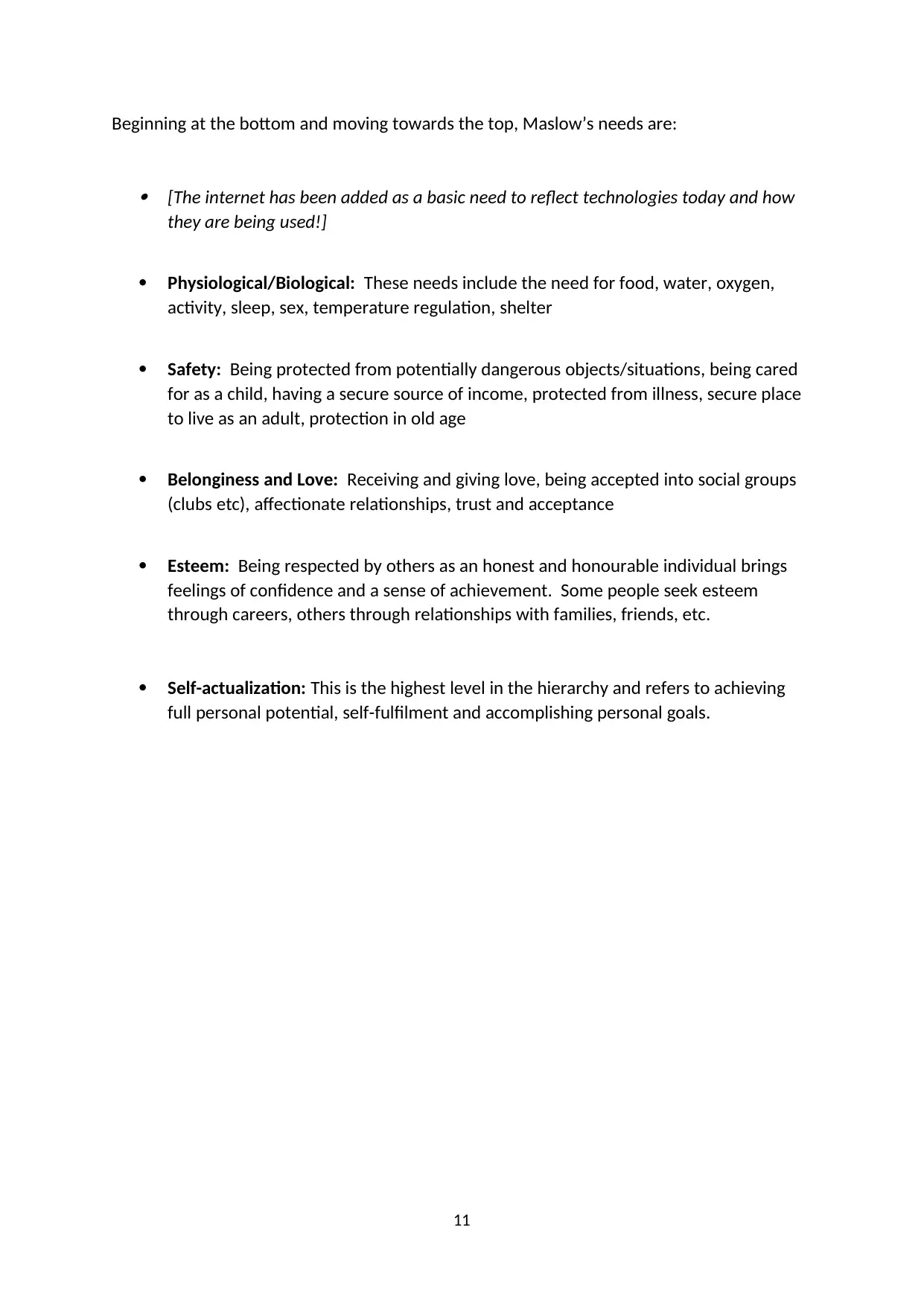
Beginning at the bottom and moving towards the top, Maslow’s needs are:
[The internet has been added as a basic need to reflect technologies today and how
they are being used!]
Physiological/Biological: These needs include the need for food, water, oxygen,
activity, sleep, sex, temperature regulation, shelter
Safety: Being protected from potentially dangerous objects/situations, being cared
for as a child, having a secure source of income, protected from illness, secure place
to live as an adult, protection in old age
Belonginess and Love: Receiving and giving love, being accepted into social groups
(clubs etc), affectionate relationships, trust and acceptance
Esteem: Being respected by others as an honest and honourable individual brings
feelings of confidence and a sense of achievement. Some people seek esteem
through careers, others through relationships with families, friends, etc.
Self-actualization: This is the highest level in the hierarchy and refers to achieving
full personal potential, self-fulfilment and accomplishing personal goals.
11
[The internet has been added as a basic need to reflect technologies today and how
they are being used!]
Physiological/Biological: These needs include the need for food, water, oxygen,
activity, sleep, sex, temperature regulation, shelter
Safety: Being protected from potentially dangerous objects/situations, being cared
for as a child, having a secure source of income, protected from illness, secure place
to live as an adult, protection in old age
Belonginess and Love: Receiving and giving love, being accepted into social groups
(clubs etc), affectionate relationships, trust and acceptance
Esteem: Being respected by others as an honest and honourable individual brings
feelings of confidence and a sense of achievement. Some people seek esteem
through careers, others through relationships with families, friends, etc.
Self-actualization: This is the highest level in the hierarchy and refers to achieving
full personal potential, self-fulfilment and accomplishing personal goals.
11
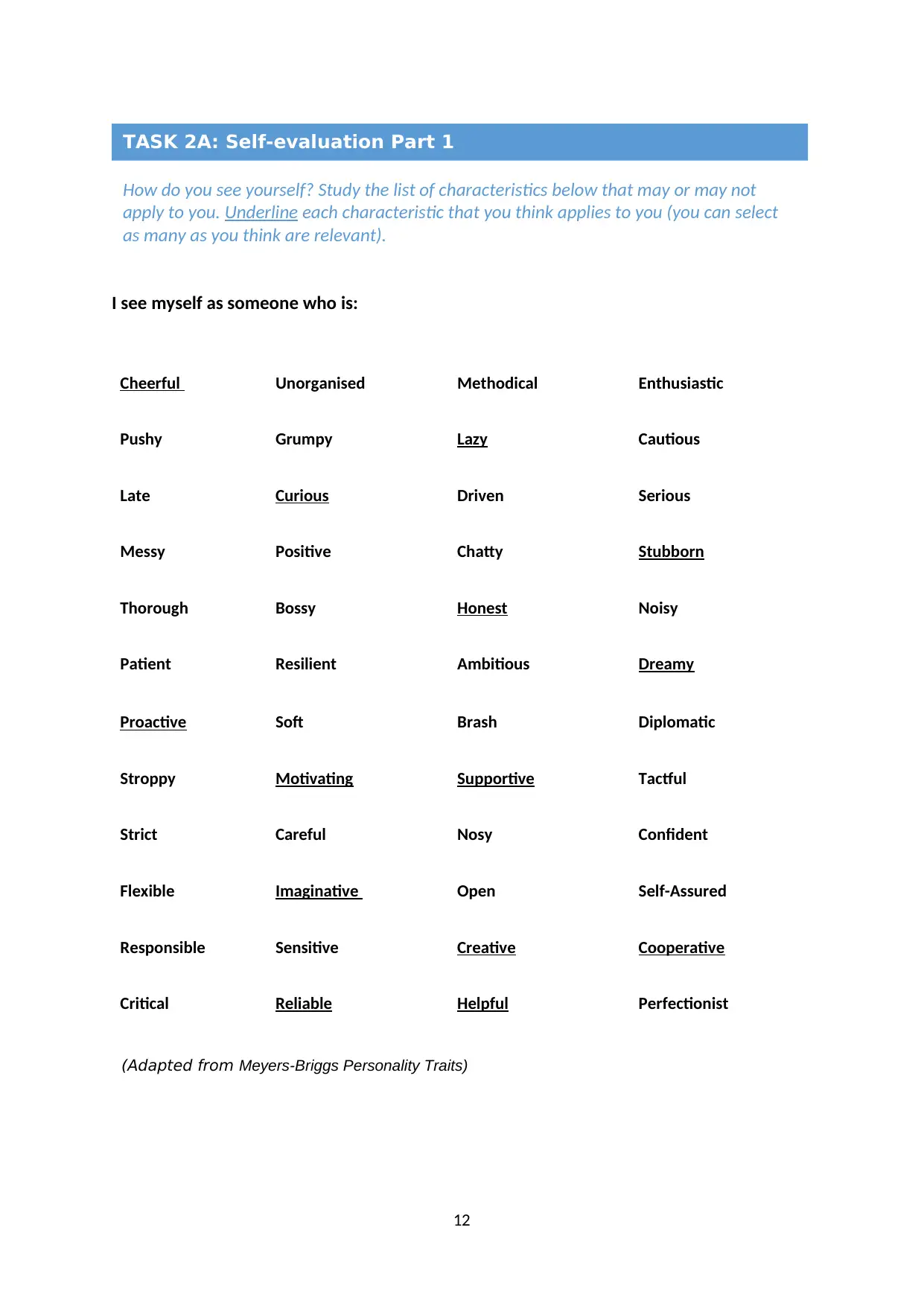
I see myself as someone who is:
Cheerful Unorganised Methodical Enthusiastic
Pushy Grumpy Lazy Cautious
Late Curious Driven Serious
Messy Positive Chatty Stubborn
Thorough Bossy Honest Noisy
Patient Resilient Ambitious Dreamy
Proactive Soft Brash Diplomatic
Stroppy Motivating Supportive Tactful
Strict Careful Nosy Confident
Flexible Imaginative Open Self-Assured
Responsible Sensitive Creative Cooperative
Critical Reliable Helpful Perfectionist
12
(Adapted from Meyers-Briggs Personality Traits)
TASK 2A: Self-evaluation Part 1
How do you see yourself? Study the list of characteristics below that may or may not
apply to you. Underline each characteristic that you think applies to you (you can select
as many as you think are relevant).
Cheerful Unorganised Methodical Enthusiastic
Pushy Grumpy Lazy Cautious
Late Curious Driven Serious
Messy Positive Chatty Stubborn
Thorough Bossy Honest Noisy
Patient Resilient Ambitious Dreamy
Proactive Soft Brash Diplomatic
Stroppy Motivating Supportive Tactful
Strict Careful Nosy Confident
Flexible Imaginative Open Self-Assured
Responsible Sensitive Creative Cooperative
Critical Reliable Helpful Perfectionist
12
(Adapted from Meyers-Briggs Personality Traits)
TASK 2A: Self-evaluation Part 1
How do you see yourself? Study the list of characteristics below that may or may not
apply to you. Underline each characteristic that you think applies to you (you can select
as many as you think are relevant).
⊘ This is a preview!⊘
Do you want full access?
Subscribe today to unlock all pages.

Trusted by 1+ million students worldwide
1 out of 26
Related Documents
Your All-in-One AI-Powered Toolkit for Academic Success.
+13062052269
info@desklib.com
Available 24*7 on WhatsApp / Email
![[object Object]](/_next/static/media/star-bottom.7253800d.svg)
Unlock your academic potential
Copyright © 2020–2025 A2Z Services. All Rights Reserved. Developed and managed by ZUCOL.



